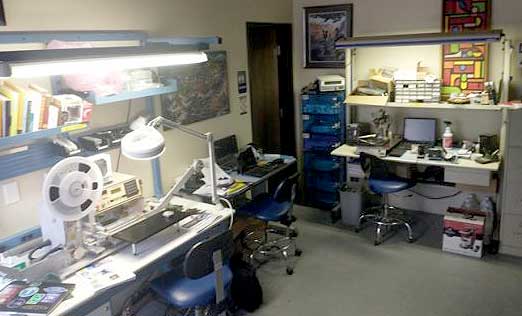Situated in the soon-to-be semiconductor hotbed of the West Valley, founder Brian Watson says he expects his company to reach $1 million in revenue this year.
Watson had worked in semiconductor modification for a couple decades when he quit his job in 2018. He wanted to start a new company that would use better automated processes. “I spent a solid two and a half years researching how to outdo myself,” he says.
He launched HyRel Technologies with co-founder Scott Baker at the end of 2021. The company incubated at Reliable Circuits Manufacturing, then in Torrance, California, for about nine months. The goal was to move to Arizona, and Watson brought the manufacturing operation to Peoria in July 2022 with help from Jennifer Stein and David Valenzuela of Peoria Economic Development Services.”We are in where the next semiconductor explosion of companies is going to happen,” Watson says. “We are strategically located in the West Valley to access not only TSMC but the other companies that are moving in. It also gives us great access down into Tempe and Chandler.”
HyRel Technologies offers component modification services that make semiconductors more reliable. The need for modification arises because manufacturers make electronic components lead-free due to the Restriction of Hazardous Substances in Electrical and Electronic Equipment directive.
“The problem with that is lead-free tends to act like a collision of two trains head on,” Watson explains. “What happens is they grow tin whiskers, and the whiskers will grow from one lead to the next or one device to the next device because of the population density of circuit boards now.” These crystalline structures can short out circuits and cause devices to fail.
“In the U.S. and in a couple very specific areas in Europe, there are exceptions to use tin lead parts,” Watson continues. HyRel Technologies accepts components that have completed final testing and packaging at a fabrication plant, and it uses processes such as retinning or reballing to add the tin lead back. It then tapes and packages the modified components.

HyRel Technologies serves customers in commercial, military, aerospace, communications, and medical fields and sells through a nationwide network of representatives. Watson says that the company hasn’t been impacted by supply chain disruptions in sourcing the materials it needs, but chip shortages have led to increased demand for its quick-turn solutions.
“It could take upwards of a year or more to get some components,” Watson notes. “And if you’ve been waiting to get the components, we’re the final stop before final assembly. So, no one wants to wait another two, three months to get their parts back.”
Watson also expects the passage of the CHIPS Act to drive growth for his business. He predicts HyRel Technologies will reach $1 million in revenue in 2023 and $15 to $20 million within five years.
Photos courtesy HyRel Technologies
HyRel Technologies currently uses 4,000 square feet of its facility and has the option to go up to 20,000 square feet. Access to the manufacturing environment is closely guarded because of how advanced the equipment is. About 20 automated machines allow for largely touchless manufacturing, and Watson is looking into process patents for his improvements to the robotic platform.
“From the point that the parts come in to the points that the parts go out, there’s maybe a limit of two touch points versus anywhere from 11 to 13 by my competitors,” Watson explains. “Our competitors are using machines that take six to eight minutes to cycle one part through. We’re cycling parts through anywhere from 10 to 15 seconds and in multiple.” ESD flooring and climate controls maintain cleanroom conditions.
Challenges: Like other manufacturers in the semiconductor industry, HyRel Technologies faces challenges with finding skilled labor. Watson doesn’t view the difficulty as a roadblock; instead, it spurs him to create pathways for students to enter the industry. “We actually embraced that and went out to find our own creative solutions,” he says.
This includes an innovative effort to introduce high school students to careers in semiconductor manufacturing and create a talent pipeline. “No one has really addressed how to supply the labor workforce that’s going to be required not only for TSMC, but for the 40 to 75 other companies that are coming here,” he notes.
He’s collaborating with three local high schools. This semester, the initiative has placed five interns. “We have a team of three kids working on the microrobotic platform that are doing just amazing work,” he says. “I’ve got two kids at Reliable Circuits Manufacturing, and they’re learning soldering skills plus circuit assembly.” Next year, 30 to 50 students will participate at different companies around the Valley. Watson hopes to grow the program to provide courses on semiconductor fabs, chip design, and Mandarin language.
Opportunities: “Our opportunities are boundless,” Watson says. “We are the sixth company in a very narrow niche market.” He adds that business is booming because HyRel Technologies can provide a higher standard of service than its competitors and because it saves customers significant amounts of money.
Needs: HyRel Technologies is currently self-financed, but Watson is considering grants or a partnership to provide additional funding. “It depends on what a financial partner could offer us,” he says. “It has to be more than just financial, because we can organically grow and then plow the money back into the robotic platforms.”










